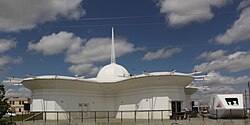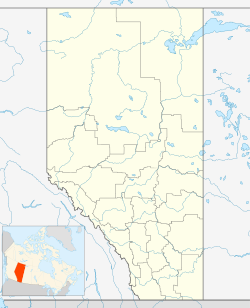Vulcan, Alberta
| Vulcan | |
|---|---|
| Town | |
| Town of Vulcan | |

Tourism and Trek Station
|
|
| Location of Vulcan in Alberta | |
| Coordinates: 50°24′24″N 113°15′18″W / 50.40667°N 113.25500°W | |
| Country |
|
| Province |
|
| Region | Southern Alberta |
| Census division | 5 |
| Municipal district | Vulcan County |
| Incorporated | |
| • Village | December 23, 1912 |
| • Town | June 15, 1921 |
| Government | |
| • Mayor | Thomas Grant |
| • Governing body | Vulcan Town Council |
| • MP | John Barlow (Macleod-Cons) |
| • MLA | Dave Schneider (Little Bow-Wildrose Party) |
| Area (2016) | |
| • Land | 6.34 km2 (2.45 sq mi) |
| Elevation | 1,049 m (3,442 ft) |
| Population (2016) | |
| • Total | 1,917 |
| • Density | 302.3/km2 (783/sq mi) |
| Time zone | MST (UTC−7) |
| • Summer (DST) | MDT (UTC−6) |
| Postal code span | T0L 2B0 |
| Area code(s) | +1-403, +1-587 |
| Highways |
Highway 23 Highway 534 |
| Railways | Canadian Pacific Railway |
| Website | Official website |
Vulcan is a town in the prairies of southern Alberta, Canada, within Vulcan County. It is located on Highway 23, midway between the cities of Calgary and Lethbridge. The population of the town was 1,836 in 2011.
Vulcan was named by a surveyor for the Canadian Pacific Railway after the Roman God of Fire – Vulcan. Originally, all the streets of Vulcan were named after gods and goddesses of the classical world such as Juno, Mars, and Jupiter. The community was incorporated as a village on December 23, 1912 and then as a town on June 15, 1921. In July 1927, a major tornado destroyed many homes and the new curling rink in the town. That tornado was made famous when a photograph of it approaching Vulcan was used for the "tornado" article in Encyclopædia Britannica.
Vulcan once had nine grain elevators, more than any other location west of Winnipeg, making it the largest grain shipping point at that time. Due to the changing economics of the agricultural industry, the original elevators were taken down one by one. Today, Vulcan has only one of the "prairie skyscrapers" left that once could be seen miles away. Although not original, this last wooden elevator was built in the 1980s.
A British Commonwealth Air Training Plan air force base, RCAF Station Vulcan, was located a few kilometres southwest of the town during the Second World War. Many of the old hangars still exist and the runways can still be seen.
...
Wikipedia

